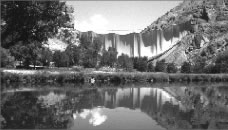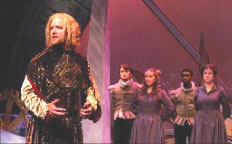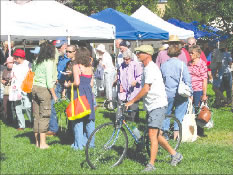In January 1971, Christo marched up the steps of city hall in Rifle, Colorado and announced that he wanted to stretch a curtain 1,200 feet across Rifle Gap, a dramatic opening in the Grand Hogback several miles north of town. The city responded, “Sounds great. When would you like to start?”

In 1971-72, Rifle was a fairly remote town with a population of 2,100. Its fairly remote location and agricultural-based lifestyle meant that the town was still about twenty years behind the times. The convulsions of the 1960s had done little to erode the values of conservatism and self-reliance that had shaped the character of Rifle for decades. Subject to the fits and starts of a local economy based in part on the going price of a barrel of oil, local business leaders were always on the lookout for a way to promote the town. They saw the Valley Curtain project as a way to increase business in the short term, and strengthen Rifle’s name recognition in the years to come.
Acceptance of the proposal was of course not universal. “Some people thought he was just nuts.” said Connie Guerette, who was a high school student at the time. “You’ve got to realize, back in 1972 this was still a farming and ranching community.” Christo proceeded to introduce the proposal to any group that would listen, addressing the Chamber of Commerce and other organizations. He seemed to strike precisely the right stance as he introduced this wildly improbable idea, that is, deadly serious. His refusal to entertain ridicule and even incredulity simply made him more impressive to people who knew bedrock chutzpah when they saw it. The people of Rifle, enough of them anyway, were won over to the project in a remarkably short time.
A Christo project is generally most successful when some level of controversy helps to raise public awareness; the more general outrage, the better. The population of Rifle was cheerfully noncompliant in this regard. Fortunately, the engineering firm and general contractor retained to build the project provided more than enough difficulties to make the Valley Curtain story interesting and compelling. Lev Zetlin Co. had an international reputation for creating innovative structural systems over large spans – seemingly a perfect fit for helping to realize an artist’s daring vision. But a crucial letter from the Colorado Department of Highways to the firm, with a list of technical questions, somehow went unanswered for more than two months. When Zetlin finally got around to responding, the chief engineer at state highways was as mad as somebody who’d been stood up for a date. It also was discovered that the engineers had designed the main concrete anchors without ever bothering to fly out from New York and inspect the unstable soil the anchors were supposed to be attached to.
The entire project was nearly scuttled by the highway department and wound up under the consternated deliberations of the governor of Colorado.
This situation come to a head in late May 1971, and the business leaders of Rifle swung into action to save the project. Store owners sent letters to the governor. The manager of the golf course which abuts Rifle Gap pulled strings with the Lieutenant Governor, who was a personal friend. The owner of the local radio station conducted a phone-in survey and announced that 123 out of 150 local callers favored the project. He later set up a conference call to the governor that included the mayor of Rifle, president of the local bank, and a member of the Chamber of Commerce. A permit from the department of highways was finally issued in July 1971.
This remarkable coalition of local supporters is not unusual in the preliminary stages of a Christo project. It is one of the peculiar mechanisms in which art becomes real life; art that has sought to establish itself outside the confines of a museum. Christo came of age as an artist during the late 1950s, in the midst of the dramatic abandonment of pristine “gallery art.” Fragments of urban life, with all their indecorous immediacy, were introduced into painting. Old socks and stuffed chickens became incorporated into the new generation of painting and sculpture, imposing the random quality of modern life. Conversely, many artists began bringing their craft out to the world, staging art events outdoors and engaging the public in these activities; and depending upon interaction with viewers for a successful completion of the project at hand.
[InContentAdTwo]
The engagement of the Rifle leaders in behalf of the Valley Curtain project was a manifestation of this new form of art, and more remarkable because the coalition helping to complete this radical work of art were members of a very conservative polity. This social coherence became an important measure of the project’s success.
This eventual success had to be reassuring to Christo and Jeanne-Claude, because the first unfurling of Valley Curtain was a technical disaster. Morrison-Knudsen, the contractor for the project, had participated in building such mighty American landmarks as Hoover Dam and the Alaska Pipeline, but M-K barely muddled through Valley Curtain. Finally, on the day before the Curtain was to be unfurled in October 1971, the Morrison-Knudsen supervisor suspended the wrapped curtain in a vulnerable position, over the objections of Christo and Jeanne-Claude, and the fabric came loose in the evening winds and was destroyed.
“I wish I could’ve had a picture of the two of them when that first curtain failed,” said Harry Odgers who manned the ambulance for the project. “It was an image of dejection, the two of them standing there with his arm around her and tears running down their faces.” The town was sympathetic, and lobbied Christo to return and complete Valley Curtain the following year. It was successfully unfurled on August 10, 1972.
Rifle Gap shows little evidence at first glance that a massive construction project ever took place in the narrow valley. There is an oddly shaped retaining structure along the road, and the original anchors are visible several hundred feet up, if you know where to look for them. Otherwise, it is only upon careful examination of the site that one can see the traces of a small army of laborers and iron workers who installed what was the equivalent of a small suspension bridge. I spoke with Lloyd Wilson, who owned part of Rifle Gap during Valley Curtain. He said, “There were rumors that he’d left a big mess there, and that of course just wasn’t true. He did everything he’d said he would do.” Wilson grew up in Rifle, and after graduating high school wound up flying for the Navy. His intimate familiarity with the landscape, especially from the air, is probably responsible for a unique assessment of Valley Curtain. After the second Valley Curtain failed in the wind the day after opening and split down the middle, he observed that the curtain seemed like a “check valve” for the Grand Hogback. The remark suggests an understanding of how the vast landscape of the Colorado River valley had been re-shaped, reconfigured by an artist working at an unprecedented scale.
Even with its inherent problems, the Valley Curtain was ultimately a huge technical and artistic success.
– Keith Howard



